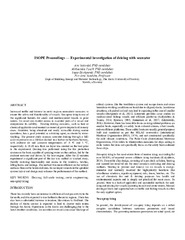Experimental Investigation of Deicing with Seawater
Abstract
Increased traffic and interest in arctic regions necessitate measures to ensure the safety and functionality of vessels. Sea-spray icing is one of the significant hazards for small- and medium-sized vessels in polar waters. Ice cover can restrict access to essential parts of a vessel and compromise its stability. Existing deicing measures, such as heat or chemical application and manual ice removal, prove impractical in many cases. Seawater, being abundant and easily accessible during marine operations, has a good potential as a deicing agent, as shown by wave-washing. The present study assesses seawater deicing through a full-scale experiment on a lifeboat docked in a harbor in Northern Norway, with ambient air and seawater temperatures of −8 °C and 3 °C, respectively. A 10-20 mm thick ice layer was created on the boat prior to the experiment. Deicing was performed using the fire protection system on the boat, capable of spraying water on the surface, fed by the ambient seawater and driven by the boat engine. After the 32-minutes experiment a significant part of the ice was melted or washed away, thereby restoring functionality and access to the windows, hatches, lifting hooks and railings. The method was more efficient on the vertical surfaces than on the horizontal ones. Some improvements in the sprinkler system layout and design may enhance the performance of the method.
Description
Is part of
Sæterdal, A.S. (2024). Marine winterization - Measures to abate sea-spray icing. (Doctoral thesis). https://hdl.handle.net/10037/35898Publisher
ISOPECitation
Sæterdal, Visich, Deshpande, Sundsbø: Experimental Investigation of Deicing with Seawater. In: ISOPE 2023. Proceedings of the Thirty-third (2023) International Ocean and Polar Engineering Conference, Ottawa, Canada, June 19-23, 2023 - ISOPE 2023, 2023. International Society of Offshore & Polar EngineersMetadata
Show full item recordCollections
Copyright 2023 The Author(s)


 English
English norsk
norsk